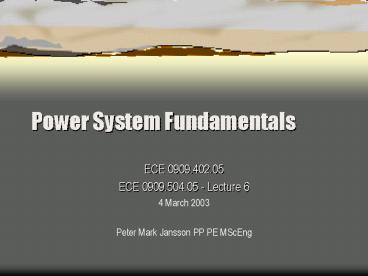Power System Fundamentals PowerPoint PPT Presentation
1 / 22
Title: Power System Fundamentals
1
Power System Fundamentals
- ECE 0909.402.05
- ECE 0909.504.05 - Lecture 6
- 4 March 2003
- Peter Mark Jansson PP PE MScEng
2
Aims
- Homework Review
- Problem 1-18
- Problem 1-19
- Sample EIT Test Problems (HW 3)
- Chapter 3 Transformers
- Chapter 4 AC Machinery Fundamentals
3
Tour Logistics
- Next Monday (10 March 2003)
- Worldcom Back-Up Power Facility
- Philadelphia (Center City)
- ALL meet here at 745 a.m.
- 2 cars needed
4
Chapter 3
- Transformers
- Benefits of Transformers (Completed)
- Types and Construction, The Ideal Transformer
- Transformer Efficiency and Voltage Regulation
- Transformer Taps
- Autotransformers
- 3-? Transformer connections
- Y-Y, Y-?, ?-Y, ?-?
5
Types and Construction
- Types
- POWER transformer
- Voltage sampling
- Current Sampling
- Impedance transformation
- Construction
- Core form
- Shell form
6
Take it apart
- Cores are constructed of laminations electrically
isolated from each other to minimize eddy
currents - Primary and secondary windings are wrapped on top
of each other (in some smaller size units they
can be wound bifilar with center taps) - In larger units it simplifies insulation of Hi-V
from core and reduces leakage flux
7
Names of Types
- POWER
- Unit Transformer output of generation steps-up
to transmission voltages (110kV or higher) - Substation Transformer lowering transmission to
distribution voltage (2.3-34.5 kV) - Distribution Transformer lowers distribution
voltage to household or business levels (110,
208, 240/480V) - SPECIAL-PURPOSE Instrument Txs
- Potential Transformer samples hi-voltage for
instruments - Current Transformer samples hi-currents for
instruments
8
The Ideal Transformer
- Lossless device w/ Input winding and output
winding
9
Ideal Transformer and Phasors
- Magnitudes change, V I phase angles do not
10
Power in the Ideal Transformer
11
Real Transformer Efficiency
- In a real transformer current flows in the
primary even when there is no load (or an open
circuit) on the secondary - Why?
12
Magnetization and Core Losses
- Magnetization current the current required to
produce a flux in the core of the transformer - Core-Loss current the current required to make
up for the hysteresis and eddy current losses
13
Transformer losses
- Copper (I2R) losses in both coils
- Eddy current losses in the transformer core
- Hysteresis losses in magnetic domains of
laminations - Leakage flux that escapes the core and pass
through only one winding which produce self
inductance
14
Transformer efficiency
15
Transformer Taps
- Typical Installation (load usually disconnected)
- 5.0 tap
- 2.5 tap
- Nominal Rating
- -2.5 tap
- -5.0 tap
- Which has more or less turns in the secondary?
16
Voltage Regulation
- TCUL tap changing under load transformer
- A.K.A. - the voltage regulator
- Uses built-in voltage sensing circuitry which
automatically changes taps to keep system voltage
supported - Very common in modern power systems
17
Autotransformers
- Sharing a common winding with either
- additional turns in series for a step-up
autotransformer - or a tap located before the terminal ends of the
common coil for a step-down autotransformer
18
3-? Transformation options
- Almost all major power systems are three phase AC
systems - Transformers that serve three phase circuits are
constructed in one of two ways - 3 single-phase transformers (3 cores)
- 1 three-phase transformer wound on a single
three-legged core
19
Preferred Option today
- Lighter, cheaper and slightly more efficient the
three-phase approach is preferred. - Older method used three units which allowed for
individual replacement if there was a fault - Many installations today still have three single
phase transformers in operation
20
Wye (Y) connection
21
Delta (?) connection
22
3-? Transformer connections
- Y-Y connection
- VLP / VLS a
- Very rarely used due to stability problems
- Y-? connection
- VLP / VLS ?3 a (phase shifts exist)
- ?-Y connection
- VLP / VLS a/?3 (phase shifts exist)
- ?-? connection
- VLP / VLS a
- No problems with unbalanced loads or phase shift

